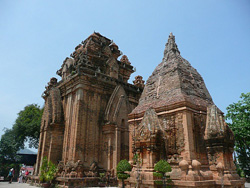Po Nagar Cham Towers

The Cham towers of Po Nagar were built between the 7th and 12th centuries. The site was used for Hindu worship as early as the 2nd century AD. Today, both ethnic Chinese and Vietnamese Buddhists come to Po Nagar to pray and make offerings, according to their respective traditions. This site has a continuing religious significance, so do remember to remove your shoes before entering.
The towers serve as the Holy See, honouring Yang lno Po Nagar, the goddess of the Dua (Liu) clan, which ruled over the southern part of the Cham kingdom covering Kauthara and Pan Duranga (present day Khanh Hoa and Thuan Hai provinces). The original wooden structure was razed to the ground by attacking Javanese in AD 774 but was replaced by a stone-and-brick temple (the first of its kind) in 784. There are stone slabs scattered throughout the complex, most of which relate to history or religion, and provide insight into the spiritual life and social structure of the Cham.
Originally the complex covered an area of 500 sq metres and there were seven or eight towers, four of which remain. All of the temples face east, as did the original entrance to the complex, which is to the right as you ascend the hillock. In centuries past, a person coming to pray passed through the pillared meditation hall, 10 pillars of which can still be seen, before proceeding up the staircase to the towers.
The 28m-high North Tower (Thap Chinh), with its terraced pyramidal roof, vaulted interior masonry and vestibule, is a superb example of Cham architecture. One of the tallest Cham towers, it was built in AD 981 by Pangro, a minister of King Harivarman 1, after the original temples here were sacked and burned. The raiders also carried off a linga made of precious melal. In AD 918 King Indravarman 111 placed a gold mukha-linga in the North Tower, but il too was taken, this time by the Khmers. This pat-lern of statues being destroyed or stolen and then replaced continued for some time until 965, when King lava Indravarman 1 replaced the gold mukha-linga with the stone figure, Uma (shakti, or a feminine manifestation ol Shiva), which remains to this day.
Above the entrance to the North Tower, two musicians flank a dancing four-armed Shiva, one of whose feet is on the head of the bull Nandin. The sandstone doorposts are covered with inscriptions, as are parts of the walls of the vestibule. A gong and a drum stand under the pyramid-shaped ceiling of the antechamber. In the 28m-high pyramidal main chamber, there is a black stone statue of the goddess Uma (in the shape of Bhagavati) with 10 arms, two of which are hidden under her vest; she is seated and leaning back against some sort of monstrous animal.
The Central Tower (Thap Nam) was built partly of recycled bricks in the 12th century on the site of a structure dating from the 7th century. It is less finely constructed than the other towers and has little ornamentation; the pyramidal roof lacks terracing or pilasters, although the interior altars were once covered with silver. There is a linga inside the main chamber. Note the inscription on the left-hand wall of the vestibule.
The South Tower (Mien Dong Nam), at one time dedicated to Sandhaka (Shiva), still shelters a linga. The richly ornamented Northwest Tower (Thap Tay Bac) was originally dedicated to Gsnesha. The pyramid-shaped summit of its roof has disappeared. The West Tower, of which almost nothing remains, was constructed by King Vikran-tavarman during the first half of the 9th century. Near the North Tower is a small museum with a few mediocre examples of Cham stonework; the explanatory signs are in Vietnamese only. At one time there was a small temple on this site.
The towers of Po Nagar stand on a granite knoll, 2km north of central Nha Trang and on the banks of the Cai River. To get here from central Nha Trang, take Quang Trung street (which becomes 2 Thang 4 street) north across Ha Ra and Xom Bong Bridges, which span the mouth of the Cai River. Po Nagar can also be reached via the new Tran Phu Bridge along the beachfront road.
ot only are the towers famous for their architecture and sculpture, but they are also well known for their great significance in history, nationalism, and archaeology.
Standing on the top of the hill, one can admire the beautiful landscapes of the coastal region of Nha Trang.
Originally the complex covered an area of 500 sq metres and there were seven or eight towers, four of which remain. All of the temples face east, as did the original entrance to the complex, which is to the right as you ascend the hillock. In centuries past, a person coming to pray passed through the pillared meditation hall, 10 pillars of which can still be seen, before proceeding up the staircase to the towers.
The 28m-high North Tower (Thap Chinh), with its terraced pyramidal roof, vaulted interior masonry and vestibule, is a superb example of Cham architecture. One of the tallest Cham towers, it was built in AD 981 by Pangro, a minister of King Harivarman 1, after the original temples here were sacked and burned. The raiders also carried off a linga made of precious melal. In AD 918 King Indravarman 111 placed a gold mukha-linga in the North Tower, but il too was taken, this time by the Khmers. This pat-lern of statues being destroyed or stolen and then replaced continued for some time until 965, when King lava Indravarman 1 replaced the gold mukha-linga with the stone figure, Uma (shakti, or a feminine manifestation ol Shiva), which remains to this day.
Above the entrance to the North Tower, two musicians flank a dancing four-armed Shiva, one of whose feet is on the head of the bull Nandin. The sandstone doorposts are covered with inscriptions, as are parts of the walls of the vestibule. A gong and a drum stand under the pyramid-shaped ceiling of the antechamber. In the 28m-high pyramidal main chamber, there is a black stone statue of the goddess Uma (in the shape of Bhagavati) with 10 arms, two of which are hidden under her vest; she is seated and leaning back against some sort of monstrous animal.
The Central Tower (Thap Nam) was built partly of recycled bricks in the 12th century on the site of a structure dating from the 7th century. It is less finely constructed than the other towers and has little ornamentation; the pyramidal roof lacks terracing or pilasters, although the interior altars were once covered with silver. There is a linga inside the main chamber. Note the inscription on the left-hand wall of the vestibule.
The South Tower (Mien Dong Nam), at one time dedicated to Sandhaka (Shiva), still shelters a linga. The richly ornamented Northwest Tower (Thap Tay Bac) was originally dedicated to Gsnesha. The pyramid-shaped summit of its roof has disappeared. The West Tower, of which almost nothing remains, was constructed by King Vikran-tavarman during the first half of the 9th century. Near the North Tower is a small museum with a few mediocre examples of Cham stonework; the explanatory signs are in Vietnamese only. At one time there was a small temple on this site.
The towers of Po Nagar stand on a granite knoll, 2km north of central Nha Trang and on the banks of the Cai River. To get here from central Nha Trang, take Quang Trung street (which becomes 2 Thang 4 street) north across Ha Ra and Xom Bong Bridges, which span the mouth of the Cai River. Po Nagar can also be reached via the new Tran Phu Bridge along the beachfront road.
ot only are the towers famous for their architecture and sculpture, but they are also well known for their great significance in history, nationalism, and archaeology.
Standing on the top of the hill, one can admire the beautiful landscapes of the coastal region of Nha Trang.
Tin tức liên quan
- Vietnamese second most confident in Asia-Pacific about post-pandemic travel: survey (24/6/2022)
- Kayaking in Việt Nam’s most beautiful places (24/04/2021)
- Da Nang tops Google list of 10 trending destinations for 2020
- Explore Vân Long Wetland Nature Reserve in Ninh Bình
- Hà Nội Train Street among Top 8 over-touristed sites (03/12/2019)
- VNAT hosts famtrip to explore sea and island tourism products in Quang Nam and Quang Ngai
- Travel Daily News lists amazing ways to see Viet Nam (21/06/2019)
- Ha Noi serves nearly 14.4 million visitors so far (21/06/2019)
- CNN praises Hoi An as one of the most beautiful towns in Southeast Asia (19/06/2019)
- Quang Ninh has additional sea and island tourism site (14/06/2019)
Tìm kiếm
Tour
Hotel
Keyword
Location
Location
Star
Type







